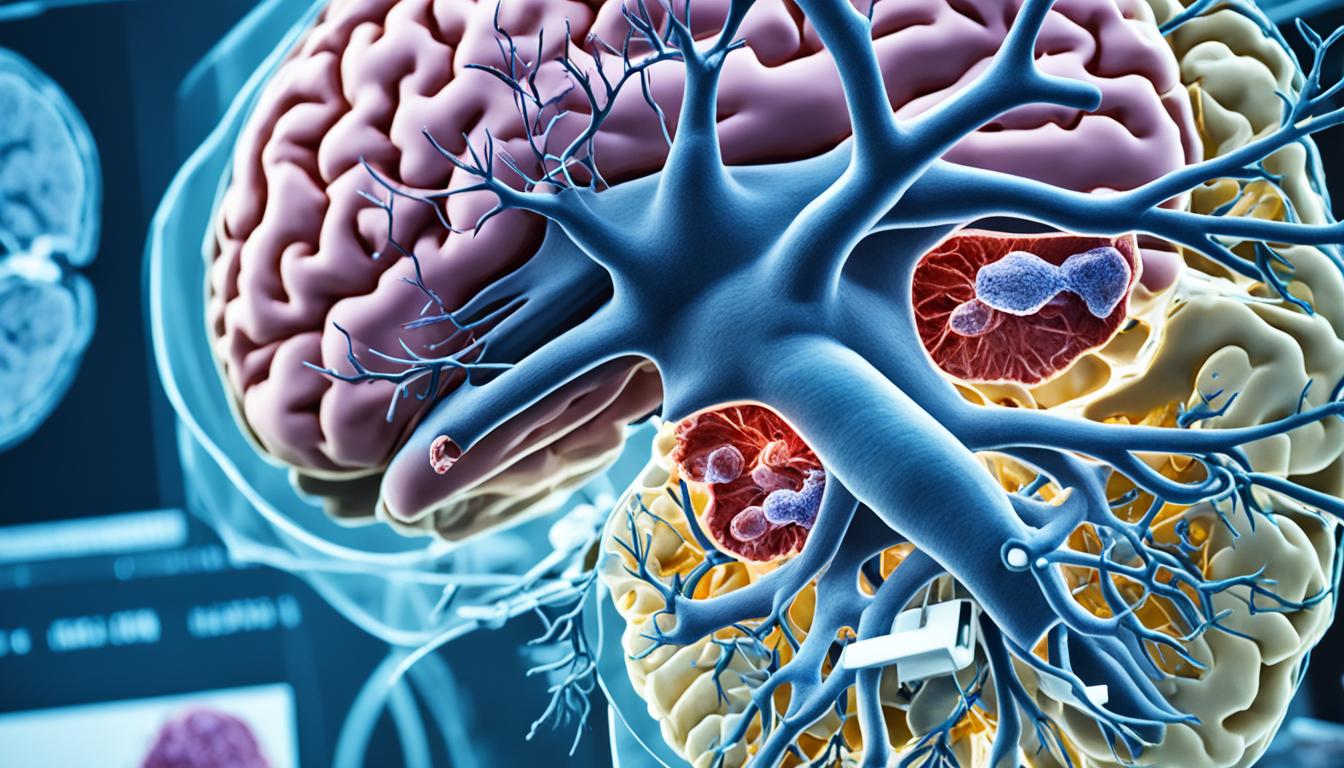Choroid plexus carcinoma (CPC) is very rare and mainly affects children. It makes up about 2% to 4% of childhood brain tumors. This type of cancer starts in the choroid plexus epithelium. It’s usually found in the lateral ventricles of the brain, then the fourth and third ventricles.
Patients with CPC might experience a headache, see double, or have problems with coordination. These signs result from fluid buildup in the brain. Hydrocephalus, or excess brain fluid, is a typical symptom. The causes of this cancer aren’t fully understood. However, it may link to inherited conditions like Li-Fraumeni syndrome.
Doctors use physical exams and brain scans to diagnose CPC. Treatments include surgery to remove the tumor, along with radiation and chemotherapy. Excitingly, stem cell therapy is being researched. This treatment offers hope for better outcomes in children with this aggressive cancer.
Key Takeaways:
- Choroid plexus carcinoma is a rare and highly aggressive malignant tumor that primarily affects children.
- Common symptoms of choroid plexus carcinoma include headache, diplopia, ataxia, and hydrocephalus.
- The exact causes of choroid plexus carcinoma are unknown, but it has been associated with certain hereditary conditions.
- Diagnosis involves physical and neurological examinations, as well as imaging tests such as CT and MRI scans.
- Treatment options for choroid plexus carcinoma include surgery, radiation therapy, and chemotherapy.
- Stem cell therapy shows promise in improving outcomes for patients with this aggressive pediatric brain tumor.
Incidence and Characteristics of Choroid Plexus Carcinoma
Choroid plexus carcinoma (CPC) is a rare, highly aggressive tumor seen mostly in kids. About 2% to 4% of kids’ brain tumors are CPC types, and adults rarely get it. It starts in the choroid plexus and is often in the lateral ventricles or other brain areas.
This cancer mainly impacts kids aged 2-4, with diagnosed children usually around 2 years old. It’s known for spreading to nearby brain tissues and traveling in the cerebrospinal fluid. This aggressive behavior makes the outlook not good, especially if it spreads in the brain or seeds the fluid.
Epidemiology
CPC is rare among children’s brain cancers. Around 2 to 4 kids out of every 100 with brain tumors will have this type.
Location and Symptoms
This cancer can be found in different parts of the brain. Often, it blocks the flow of cerebrospinal fluid, leading to hydrocephalus as a key sign.
Prognosis
Outlook for CPC patients is often not good because of its fast-spreading nature. If it invades the brain or spreads through the cerebrospinal fluid, the situation becomes more challenging.
Diagnosis and Treatment Planning
For diagnosis and treatment planning, CT and MRI scans are vital. They confirm the tumor, its size, and location. Genetic tests also help plan more tailored treatments.
Diagnosis and Treatment of Choroid Plexus Carcinoma
Doctors find choroid plexus carcinoma by checking a patient’s body and brain closely. They use imaging tests like CT and MRI scans. These tests show if there’s a tumor, its size, where it is, and how far it has spread. Sometimes, the doctor has to take a small part of the tumor to look at under a microscope. This is called a biopsy.
Treating choroid plexus carcinoma starts with surgery to remove the tumor. This surgery is called tumor resection. Removing the whole tumor is the best way to treat it. However, it’s not always easy because these tumors can grow deep into the brain.
After surgery, doctors might suggest more treatments to kill any cancer cells left. Radiation therapy uses strong energy to get rid of the cancer cells. Chemotherapy uses medicine to stop the cancer from coming back and spreading.
New treatments like stem cell therapy also give hope for fighting choroid plexus carcinoma. Stem cells can turn into different parts of the body. They might be able to replace damaged tissues. But, this type of treatment still needs more study to make sure it’s safe and works well.
Comparison of Treatment Options for Choroid Plexus Carcinoma
| Treatment Option | Description |
|---|---|
| Surgical Resection | Complete removal of the tumor through surgery. |
| Radiation Therapy | Use of high-energy beams to target and destroy cancer cells. |
| Chemotherapy | Administration of drugs to kill cancer cells and prevent recurrence. |
| Stem Cell Therapy | Experimental treatment using stem cells to replace damaged tissue or enhance the body’s defense against cancer. |
Conclusion
Choroid plexus carcinoma (CPC) is a rare and aggressive brain tumor. It mostly affects children. This tumor is known for spreading quickly and possibly moving to other parts of the body. Doctors diagnose CPC through physical exams, tests, and sometimes a biopsy. Treating CPC may involve surgery, radiation, and chemotherapy. Yet, the chances of beating this tumor are low. There’s a high risk that it can come back or spread.
Even though CPC is hard to treat, research is bringing new hope. Stem cell therapy is one area that looks promising. It might help make the treatment for this brain tumor better. Scientists and doctors are trying new methods, like using stem cells, to increase the chances of recovery and make life better for CPC patients.
With more knowledge and new treatments, we see a chance for better care. While CPC still poses a big challenge, the progress in medicine and research brings a ray of hope. The goal of all these efforts is to help those facing CPC and their families. The aim is to find better ways to treat this serious brain tumor. We hope to change its course by improving treatments and increasing the odds of survival.

